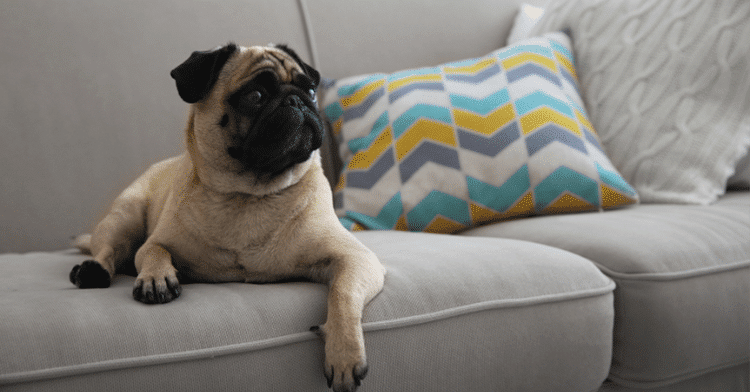Do Pugs Bark a Lot? Debunking Common Myths
Pugs, with their distinctive squished faces and expressive eyes, have captivated the hearts of dog lovers worldwide. However, a common question among prospective and current pug owners alike is: Do pugs bark a lot?
This article delves into the barking habits of pugs, debunking common myths and providing a clearer understanding of what to expect from these charming canines.
Key Takeaways
- Pugs do not inherently bark more than other breeds; their barking habits are largely influenced by their environment and upbringing.
- Comparing pugs to other dog breeds reveals that their bark is unique but not necessarily more frequent.
- The myth that pugs bark excessively is largely unfounded; understanding the reasons behind their vocalizations can help manage their barking.
- Proper training, communication, and ensuring your pug has sufficient exercise and mental stimulation can significantly reduce unnecessary barking.
- Real-life stories and experiences from pug owners highlight that, like humans, each pug has its own personality and barking habits, including some exceptionally quiet pugs.
The Bark Heard Around the World

The truth about pugs and their vocal cords
Pugs, with their squished faces and big, soulful eyes, might look like the quiet types, but don’t let appearances fool you. These little guys can be as vocal as any dog on the block. The key to understanding a pug’s bark lies not in the volume, but in the emotion behind it.
Pugs bark for a myriad of reasons, ranging from excitement to alerting their human companions of perceived threats. It’s their way of communicating in a world that’s much bigger than they are.
- Excitement
- Alerting
- Seeking attention
- Responding to other dogs
Pugs have a unique vocal range that can sometimes surprise new owners.
Don’t expect a pug to bark like a German Shepherd or howl like a Husky. Their barks are more akin to a raspy shout, a charming quirk that endears them to their fans. Understanding this can help bridge the communication gap between you and your pint-sized companion.
Comparing pug barks to other breeds
When it comes to the symphony of canine vocalizations, pugs play a unique instrument. Their barks, often described as robust and surprisingly deep for their size, contrast sharply with the high-pitched yips of smaller breeds like Chihuahuas and the thunderous roars of larger guardians like the German Shepherd. Pugs have a bark that’s distinctively their own, a blend of earnestness and a touch of comedy, much like their personalities.
- The Chihuahua: High-pitched and rapid, often in response to perceived threats.
- The German Shepherd: Deep and authoritative, used for alerting and guarding.
- The Pug: A mix of depth and whimsy, reflecting their sociable yet earnest nature.
Pugs don’t just bark to hear their own voices; they communicate. Whether it’s alerting you to the mailman or expressing boredom, their barks serve a purpose.
Understanding the nuances of pug barks compared to other breeds not only highlights their unique place in the canine chorus but also sheds light on their communicative prowess. They’re not the loudest in the pack, but they sure know how to make their presence felt.
The impact of the environment on a pug’s need to vocalize
Much like a seasoned traveler adapts to the local cuisine, a pug’s vocal tendencies can shift dramatically with its environment. The louder the surroundings, the louder the pug. It’s a simple equation, really. But it’s not just about volume; it’s about communication. In a bustling city, your pug might feel the need to shout over the noise, while in a serene countryside, it might only whisper sweet nothings into the breeze.
- Urban jungles turn pugs into vocal warriors.
- Quiet suburbs might just bring out the muse in your pug, inspiring more thoughtful, less frequent barks.
- In the great outdoors, your pug might find its inner zen and choose silence over sound.
The key here is adaptation. Pugs, like us, respond to their surroundings. They’re not just barking to hear their own voice; they’re communicating with the world around them.
Understanding this dynamic can transform how we interpret our furry friends’ vocal performances. It’s not about trying to silence them; it’s about understanding the why behind the bark. And sometimes, just sometimes, that understanding can lead to a quieter life together.
Myth-Busting: Pugs and the Tower of Babel

Debunking the myth: Do pugs really bark more?
Let’s cut through the noise, shall we? The idea that pugs bark more than other breeds is as overstuffed as a Thanksgiving turkey. But here’s the kicker: it’s not entirely about the breed. It’s about the individual dog and a cocktail of factors that influence its behavior.
- Personality
- Environment
- Attention needs
Each pug is a unique blend of these elements, making the ‘barking lot’ stereotype a bit of a stretch.
So, before you label your pug as a chatterbox, consider the context. Maybe it’s not the pug that’s noisy, but the environment that’s asking for a dialogue. Understanding this can change the way you hear their bark—turning what was once considered noise into a form of communication.
Understanding the reasons behind a pug’s bark
Pugs, like any good dish, have layers. Peeling back these layers reveals not just a penchant for snorts and grumbles but a complex communication system. Understanding the reasons behind a pug’s bark is akin to deciphering a secret menu at your favorite dive bar – it’s all about knowing what to look for.
- Attention-seeking: Much like the diner who flags the waiter for the fifth time, pugs bark to get your eyes on them.
- Alerting to danger: If there’s an intruder, be it another Amazon delivery or a squirrel, your pug is on the case, barking to alert you.
- Boredom or loneliness: A pug left alone is like a chef without a kitchen; they’ll make noise just to fill the silence.
- Response to other dogs: When the kitchen gets crowded, expect some noise; pugs respond to the barks of others, joining the cacophony.
Pugs communicate through their bark much like chefs do with their dishes – with purpose, passion, and a bit of flair.
Understanding a pug’s bark is not just about the why but also the how. It’s about tuning into their frequency, listening not just with your ears but with your heart. After all, a pug’s bark is their way of adding to the conversation, making sure their voice is heard in the bustling diner of life.
The silent types: When pugs choose not to bark
In the world of pugs, silence is not just golden; it’s a statement. Not every moment requires a soundtrack, especially in the life of a pug. These stoic little warriors choose their battles wisely, and sometimes, that means keeping their opinions to themselves.
- Understanding the context is key. A quiet pug might be content, feeling secure in its environment.
- Observing their body language offers clues. A relaxed posture suggests peace, while a tense one might hint at suppressed opinions.
- Silence can also be a sign of trust. They believe you’ve got the situation under control, so they don’t need to add their two cents.
In the tapestry of canine communication, a pug’s silence can be as eloquent as a bark.
Remember, a silent pug isn’t necessarily a disengaged or unhappy pug. It’s a creature comfortable in its silence, confident in its surroundings, and perhaps, just enjoying the moment for what it is. Embrace these quiet times as they offer a rare glimpse into the contemplative side of your pug’s personality.
The Pug Whisperer’s Guide to Silence

Training tips to reduce unnecessary barking
Taming the vocal tendencies of a pug isn’t about stifling their spirit; it’s about channeling that energy into more constructive outlets. The key is consistency. Without it, you’re just another voice in the cacophony of their world.
- Start with basic commands like ‘quiet’ or ‘no bark’. Reinforce these commands with treats and praise to make them stick.
- Diversify their activities. A bored pug is a noisy pug. Keep their minds and bodies engaged with puzzles, toys, and regular playtimes.
- Establish a routine. Pugs thrive on predictability. Knowing what to expect from their day can significantly reduce anxiety-induced barking.
Remember, every pug has its own personality. What works for one may not work for another. Patience and adaptation are your best tools in this journey.
Communicating with your pug: Understanding their needs
Understanding your pug’s needs is akin to learning a new language, one that’s filled with snorts, grunts, and, yes, barks. It’s not just about the noise; it’s about what’s behind it. Every bark has a story, whether it’s hunger, boredom, or just a plea for your undivided attention.
- Listen for patterns in their barking to identify specific needs.
- Pay attention to body language; it often speaks louder than vocalizations.
- Regularly scheduled playtime and walks can preemptively address many common causes of barking.
Mastering this language doesn’t happen overnight. It requires patience, attention, and a bit of intuition.
Remember, a well-understood pug is often a quiet one. By tuning into their unique way of communicating, you’re not just quelling noise; you’re deepening the bond. This journey of understanding is not just about reducing barks; it’s about enriching your pug’s life and, by extension, your own.
The role of exercise and stimulation in keeping the peace
In the world of pugs, a well-exercised dog is a quiet dog. The secret to a peaceful home might just lie in a good old-fashioned romp in the park. It’s not just about tiring them out; it’s about engaging their minds and satisfying their innate curiosity.
- A brisk walk in the morning
- Some quality time with puzzle toys
- A game of fetch to wind down the evening
These activities aren’t just exercises; they’re an investment in your pug’s mental health and your own sanity. A bored pug is a noisy pug, but a stimulated pug is a content pug.
Remember, the goal isn’t to exhaust your pug but to enrich their life. Finding the right balance between physical activity and mental stimulation can turn your vocal pug into the most serene companion.
Tales from the Pug Side

Real-life stories of pugs and their barking habits
Every pug has its day, and in the realm of barking, it’s no different. From the silent stares of a contemplative pug to the jubilant yelps of one finding its voice, the range is as wide as it is endearing. But let’s not kid ourselves, not all pugs are created equal when it comes to vocalizing their innermost thoughts.
- Some pugs are the strong, silent type, choosing to communicate with a look rather than a bark.
- Others wear their hearts on their sleeves, or more accurately, their barks in the air, ready to announce their presence to the world.
In the tapestry of pug vocalizations, each thread is unique, weaving a story that’s as individual as the pug itself.
The tales of pugs and their barking habits are as varied as the breeds themselves. From the pug that barked at every leaf that dared to trespass its yard, to the one that remained as stoic as a statue in the face of the mailman’s daily provocations. These stories not only entertain but shed light on the nuanced nature of our furry friends.
The pug that whispered: Unusual cases of quiet pugs
In the vast, bustling world of canine chatter, there exists a rare breed of pug that prefers the sound of silence over the cacophony of its peers. These are the pugs that whisper, the ones that turn the stereotype on its head and leave us questioning everything we thought we knew about these snub-nosed companions.
Not all pugs feel the need to vocalize their every thought. Some, through a combination of genetics, environment, and perhaps a bit of pug magic, find themselves more content in their quietude. They’re the Zen masters of the pug world, teaching us that sometimes, the most profound statements are made in silence.
- The silent pug is not a myth; it’s a reality for some. Bruce Lee is the silent type, for instance.
- These pugs often communicate through body language rather than barking.
- A quiet pug can be a sign of contentment and security.
In a world where every bark could be a novel, these pugs choose haiku. They remind us that in the realm of communication, less can indeed be more.
Celebrity pugs and their bark reputations
In the glamorous world of celebrity pets, pugs hold a special place. They’re not just accessories to the stars; they’re characters, each with their own distinct personality and, yes, barking style. Some celebrity pugs have become almost as famous as their owners, parading their unique vocalizations on social media and in paparazzi shots.
- Doug the Pug, for instance, has a following that rivals that of mid-tier influencers, known not just for his adorable face but for his expressive “comments” on life.
- Meanwhile, Otis, belonging to a certain A-lister, prefers the silent treatment, proving that not all pugs feel the need to vocalize their thoughts.
In the end, it’s not about the volume or the frequency; it’s about the message. And celebrity pugs, with their diverse range of barks, whines, and grunts, communicate in ways that captivate and entertain us all.
The Verdict on Pug Vocalizations
So, do pugs bark a lot? Like any good dish, it’s all about the ingredients – genetics, environment, and training. Pugs, with their comical faces and spirited personalities, can indeed be vocal, but they’re not leading the canine chorus in decibels. They express themselves, sure, but with the right mix of training and understanding, your pug’s barks can be more like the occasional spice rather than the main ingredient. In the grand scheme of dog barks, pugs offer a flavorful, yet manageable, symphony of sounds.
Frequently Asked Questions
Do pugs bark a lot compared to other dog breeds?
Pugs do not inherently bark more than other breeds. Their tendency to vocalize can vary based on individual personality, training, and environment. Compared to more vocal breeds like terriers, pugs are relatively moderate barkers.
What factors influence a pug’s need to vocalize?
Several factors can influence a pug’s vocalization, including genetics, environment, training, and their emotional state. Lack of socialization, boredom, fear, and seeking attention are common reasons a pug might bark more frequently.
Can you train a pug to bark less?
Yes, with patience and consistent training, you can teach a pug to bark less. Positive reinforcement techniques, such as rewarding quiet behavior and teaching ‘quiet’ commands, are effective strategies for reducing unnecessary barking.
Are there any myths about pugs and their barking habits?
One common myth is that pugs bark incessantly. In reality, pugs are not the most vocal breed, and their barking habits can be managed with proper training and care. Another myth is that pugs bark for no reason, when in fact, they usually bark to communicate specific needs or responses to their environment.
What role does exercise and stimulation play in a pug’s barking behavior?
Regular exercise and mental stimulation are crucial for a pug’s well-being and can significantly reduce unwanted barking. A well-exercised pug is less likely to bark out of boredom or excess energy, making them more content and quieter overall.
Are there any unusual cases of pugs being exceptionally quiet or vocal?
Yes, there are individual variations among pugs, with some being notably quiet and others more vocal. These differences can be attributed to their unique personalities, upbringing, and sometimes, specific training to either encourage or discourage vocalization.







